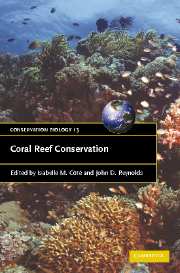Book contents
- Frontmatter
- Contents
- List of contributors
- Foreword
- Preface
- Part I Setting the stage
- 1 Status of coral reefs of the world: summary of threats and remedial action
- 2 Death and resurrection of Caribbean coral reefs: a palaeoecological perspective
- 3 A seascape-level perspective of coral reef ecosystems
- 4 Cold-water coral reefs: status and conservation
- Part II Uses and abuses: ecological and socio-economic issues
- Part III The way forward: tools and approache
- Index
- Plate section
- References
2 - Death and resurrection of Caribbean coral reefs: a palaeoecological perspective
Published online by Cambridge University Press: 05 June 2012
- Frontmatter
- Contents
- List of contributors
- Foreword
- Preface
- Part I Setting the stage
- 1 Status of coral reefs of the world: summary of threats and remedial action
- 2 Death and resurrection of Caribbean coral reefs: a palaeoecological perspective
- 3 A seascape-level perspective of coral reef ecosystems
- 4 Cold-water coral reefs: status and conservation
- Part II Uses and abuses: ecological and socio-economic issues
- Part III The way forward: tools and approache
- Index
- Plate section
- References
Summary
INTRODUCTION
In the last three decades reef corals have suffered catastrophic levels of mortality throughout the tropics, a trend which has been especially pronounced in the Caribbean and western Atlantic region (Ginsburg, 1994 Gardner et al., 2003 Ginsburg and Lang, 2003). Since the late 1970s and early 1980s, the structure of most Caribbean reefs has changed dramatically, with a fundamental shift in dominance from corals to macroalgae (Knowlton, 1992). This phase shift from coral- to macroalgae-dominated benthic reef communities has been driven largely by a drastic reduction in the abundance of branching elkhorn (Acropora palmata) and staghorn (Acropora cervicornis) corals (Aronson and Precht, 2001a, 2001b), coupled with reduced herbivory (Glynn, 1990 Carpenter, 1997).
Although the temporal and spatial signals of recent change in the Caribbean are relatively straightforward (Aronson and Precht, 2001b Gardner et al., 2003 Ginsburg and Lang, 2003 Kramer, 2003), the causes remain controversial. A number of hypotheses have been developed, with top–down (over-fishing), bottom–up (eutrophication and pollution) and side–in (habitat destruction and global change) models dominating the literature. Reliance on weak inference in many of these studies, however, has hindered the progress of reef science and confounded the direction and emphasis of ecosystem management. In this chapter, we examine the principal models and evaluate their utility as explanations of the ecological changes that have been observed on Caribbean reefs.
- Type
- Chapter
- Information
- Coral Reef Conservation , pp. 40 - 77Publisher: Cambridge University PressPrint publication year: 2006
References
- 21
- Cited by

